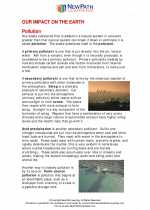Our impact on earth -> monsoons
Monsoons
A monsoon is a seasonal wind pattern that causes wet and dry seasons in certain parts of the world. These wind patterns are responsible for bringing heavy rainfall to some regions, while leaving others relatively dry. Monsoons are primarily experienced in South Asia, Southeast Asia, Australia, and parts of Africa. The most well-known monsoon is the Indian monsoon, which brings heavy rains to the Indian subcontinent during the summer months.
Characteristics of Monsoons
Monsoons are characterized by a reversal of wind direction between the summer and winter seasons. During the summer, warm, moist air from the ocean is drawn towards land, bringing heavy rainfall. In contrast, during the winter, cooler, dry air flows from the land towards the ocean, resulting in relatively dry conditions.
Causes of Monsoons
The primary factors that cause monsoons are differential heating and cooling of land and water. During the summer, the land heats up more quickly than the ocean, creating a low-pressure area over the land. This draws moist air from the ocean, resulting in heavy rainfall. Conversely, during the winter, the land cools more rapidly than the ocean, creating a high-pressure area over the land. This causes air to flow from the land towards the ocean, leading to dry conditions.
Impact of Monsoons
Monsoons play a crucial role in the climate and agriculture of the regions they affect. The heavy rainfall brought by monsoons is essential for the cultivation of crops, providing water for irrigation and supporting agricultural production. However, excessive rainfall during the monsoon season can also lead to flooding and other challenges for communities in affected regions.
Study Guide
- What is a monsoon?
- Where are monsoons primarily experienced?
- Describe the characteristics of monsoons.
- What are the primary causes of monsoons?
- How do monsoons impact the regions they affect?
- Discuss the importance of monsoons for agriculture.
◂Science Worksheets and Study Guides Sixth Grade. Our impact on earth

 Worksheet/Answer key
Worksheet/Answer key
 Worksheet/Answer key
Worksheet/Answer key
 Worksheet/Answer key
Worksheet/Answer key
 Vocabulary/Answer key
Vocabulary/Answer key
